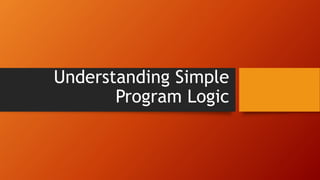
Understanding Simple Program Logic
- 2. Program Logic A program with syntax errors cannot be fully translated and cannot execute. A program with no syntax errors is translatable and can execute, but it still might contain logical errors and produce incorrect output as a result. For a program to work properly, you must develop correct logic; that is, you must write program instructions in a specific sequence, you must not leave any instructions out, and you must not add extraneous instructions.
- 3. Program Logic Suppose you instruct someone to make a cake as follows: • Get a bowl • Stir • Add two eggs • Add a gallon of gasoline • Bake at 350 degrees for 45 minutes • Add three cups of flour
- 4. Program Logic Even though the cake-baking instructions use English language syntax correctly, the instructions are out of sequence, some are missing, and some instructions belong to procedures other than baking a cake. If you follow these instructions, you will not make an edible cake, and you may end up with a disaster Many logical errors are more difficult to locate than syntax errors—it is easier for you to determine whether eggs is spelled incorrectly in a recipe than it is for you to tell if there are too many eggs or if they are added too soon.
- 5. Program Logic Most simple computer programs include steps that perform input, processing, and output. Suppose you want to write a computer program to double any number you provide. You can write the program in a programming language such as Visual Basic or Java, but if you were to write it using English-like statements, it would look like this: input myNumber set myAnswer = myNumber * 2 output myAnswer
- 6. Program Logic The instruction to input myNumber is an example of an input operation. When the computer interprets this instruction, it knows to look to an input device to obtain a number. When you work in a specific programming language, you write instructions that tell the computer which device to access for input. When the number is retrieved from an input device, it is placed in the computer’s memory in a variable named myNumber.
- 7. Program Logic The instruction set myAnswer = myNumber * 2 is an example of a processing operation. In most programming languages, an asterisk is used to indicate multiplication, so this instruction means “Change the value of the memory location myAnswer to equal the value at the memory location myNumber times two.” Mathematical operations are not the only kind of processing operations, but they are very typical. As with input operations, the type of hardware used for processing is irrelevant—after you write a program, it can be used on computers of different brand names, sizes, and speeds.
- 8. Program Logic The output myAnswer instruction is an example of an output operation. Within a particular program, this statement could cause the output to appear on the monitor, or the output could go to a printer, or the output could be written to a disk or DVD. The logic of the output process is the same no matter what hardware device you use. When this instruction executes, the value stored in memory at the location named myAnswer is sent to an output device.
- 9. THANK YOU
